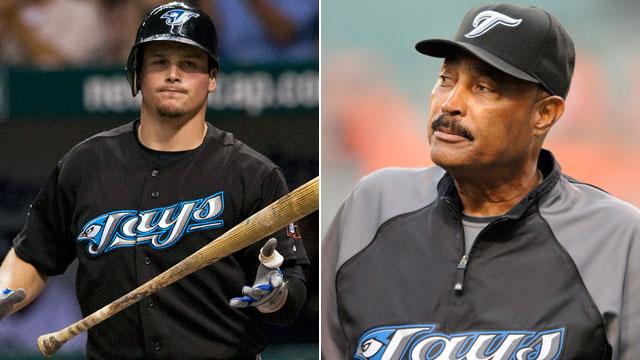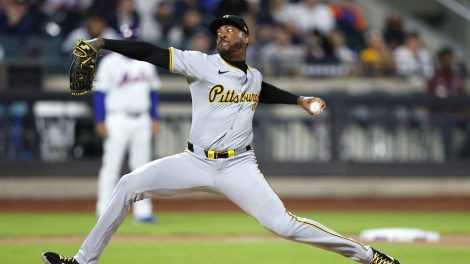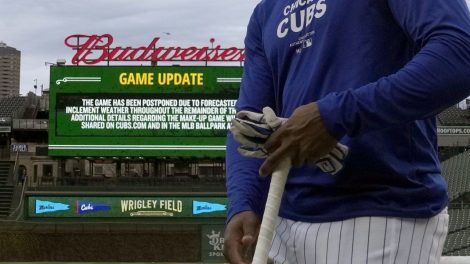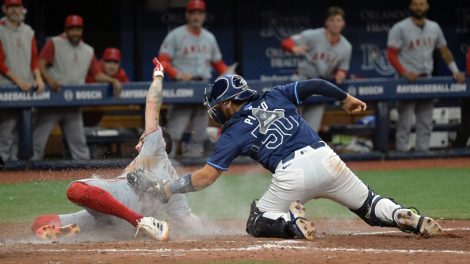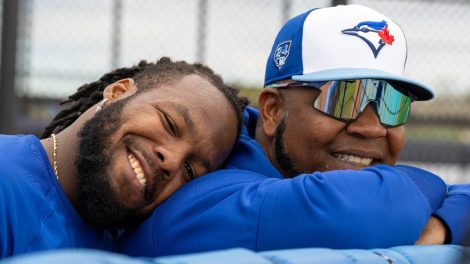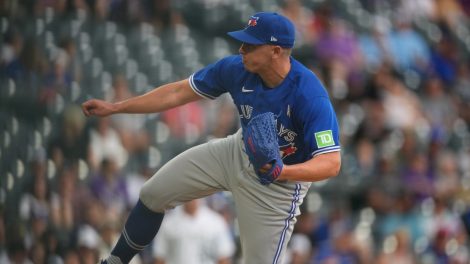Earlier this month Sportsnet’s Shi Davidi sat down for a lengthy interview with former Toronto Blue Jay Travis Snider. Over the course of 90 minutes, the 24-year-old opened up for the first time on what he believes went wrong during his once promising, yet ultimately turbulent time in Toronto.
In Part I of this three-part series, Snider recounted his rapid rise through the Blue Jays minor league system and the personality conflict with former Blue Jays manager Cito Gaston he says affected his peformance on the field.
 Tuesday, Sept. 25: Part I: Clashes with Cito
Tuesday, Sept. 25: Part I: Clashes with Cito
 Wednesday, Sept. 26: Part II: A deal gone sour
Wednesday, Sept. 26: Part II: A deal gone sour
—
—
Read @shidavidi Travis Snider exclusive bit.ly/QRDlQf and then tell us why YOU think he didn’t pan out with #bluejays @ #SniderSaga
— Sportsnet (@Sportsnet) September 25, 2012
—
PITTSBURGH – Put simply, this is the real story of how Travis Snider’s time with the Toronto Blue Jays went so remarkably wrong.
Over four-and-a-half years of difficulty, drama and ultimately disappointment – revealed here in detail for the first time – the player once destined to lead the franchise back to greatness clashed with Cito Gaston and Gene Tenace, allowed the club’s roster jockeying to get into his head, struggled to contain his frustrations, turned down a long-term contract offer, had his progress stalled by injuries, and, finally, slid down the depth chart far enough to become expendable.
By the time of his July 30, 2012 trade to the Pittsburgh Pirates, there were important lessons to be drawn for a franchise that prides itself on player development, for future can’t-miss kids who may find themselves in a situation similar to that of Snider and for the outfielder himself, now enjoying a fresh start in a new place having learned from his many mistakes.
***
Snider’s mind is racing, unsure of what to make of the words just spoken.
Barely two hours into his first day in the big-leagues, having just finished a second round in the batting cage at Yankee Stadium the afternoon of Aug. 29, 2008, the much-hyped 20-year-old prospect is staring at Blue Jays hitting coach Gene Tenace in disbelief.
"Have you always finished your swing with two hands?’" Snider remembers the veteran coach asking. "I said, ‘Yes I have, my whole life.’
He said, ‘You might want to change that if you want to stay at this level.’"
Instantly their relationship was broken, before it had started, even if as it turned out, Tenace’s first impression was right. Snider, the native of Kirkland, Wash., chosen 14th overall in the 2006 draft and widely regarded as its top high-school hitter, tore through the Blue Jays system in less than three years, climbing four levels in 2008 alone.
He arrived in the majors with an upright stance and a swing that led him to often muscle balls, but one that would also eventually keep him from catching up to fastballs inside, a bone of contention for both Tenace and Gaston. A problem they encountered, and not just with Snider, was often in how their messages were delivered.
Now retired, Tenace denies telling Snider to change his finish, though he remembers saying "sometimes you’re releasing (the bat) too soon and I told him it could be a problem from where it is. I might have brought it up to him, but I never told him he had to change it."
Either way, the commonalities in the conflicting recollections underscore how poorly the relationship started, and how it led to the lack of trust between them that followed.

"I was very proud, very hard-headed and didn’t respond to criticism in that fashion, even if it wasn’t meant as criticism," says Snider. "Trying to figure out where Geno was trying to go making a comment like that to me at 20 years old, my first day in the big-leagues … for my personality type and for how hard I worked, it was going to be very hard for me to stay open-minded to any kind of suggestions or help they would try to give me."
On the field things started well for Snider, who batted .301/.338/.466 in 24 games to close out the ’08 season, with two homers, six doubles and 13 RBIs, yet signs of trouble were there. Both Gaston and Tenace urged him to pull the ball more, and even when Snider did get hits going the other way, the coaching staff didn’t put much stock in it.
His first knock was a ground-rule double to left-centre off a low and away fastball against the Yankees in his debut, and Gaston remembers how, "I thought he was lucky, you’re not going to live on hitting balls down and away."
Given his success out of the chute, well enough was left alone, until Gaston and Tenace started to try and drive the point home during spring training in 2009. Snider resisted, feeling comfortable with where he was once camp broke, and opened the year in what was essentially a platoon. The arrangement bothered him and veteran teammates asked "What, can you not hit lefties?" to razz him – "more in question of why I wasn’t playing every day if you’re 21 with the hype that had followed me," says Snider.
Things boiled over in April with the team in Minnesota, when he sat against southpaw Glen Perkins the night after hitting two home runs.
"I felt like why haven’t I earned that opportunity to get a chance to play every day?" Snider recalls. "I lost focus on controlling what I can control. Teammates, friends, family, everybody asked and I’m the one person who kept saying, ‘No, no, no, I’m just going to keep going,’ and then at that point I was like, I don’t know what I can do more, and everything started to tailspin after that day."
The Blue Jays, Gaston explains, "were trying to ease him into it, trying to make sure he’s going to be successful, instead of shoving him out there against tough left-handers. I understand why it’s tough to understand after he hit two home runs, but there are some guys who can take it from their teammates, some guys that can’t. He’s got to be able to take it."
Already losing patience with his role on the team, things went from bad to worse for Snider when he reached his breaking point with the plan for him to discuss his approach for each at-bat with Gaston before stepping into the on-deck circle.
As Gaston recalls, then GM J.P. Ricciardi asked him to keep tabs on both Snider and Adam Lind, to see where their heads were at, and the pre-AB discussions is what he came up with.
"It was never me telling him what he wanted to do," says Gaston. "And if he said I want to hit the fastball, I’d say well hit it, just don’t swing at those breaking balls."
The whole approach was new to Snider, and he hated it.
"It put me in a position to overthink situations. I’d sit down and say this is what I’m looking for, I watched film on this guy for 30 minutes, I watched his last three starts, I have a good feel for his tendencies, and then hear, ‘No, you shouldn’t look for that, you should look for this.’"
Frustration over the arrangement mounted as his performance began to dip and at some point during a 2-for-15 series against the Royals in Kansas City, Snider visited Gaston’s office and told him he needed it to stop. "It was very obvious I was late on some fastballs," Snider admits. "We faced Zack Greinke and a couple of other hard-throwing right-handers and I was fouling balls off to the left side and I know that I’m late but I came into the dugout and a comment was made to me by Cito, I don’t remember specifically what was said, but it was like, ‘Hey, you’re late getting ready, you need to get ready earlier.’"
So the next day Snider went to visit Gaston in his office and told him that he preferred not to get critiques of his swing in-game and that he’d be happy to work through issues in the batting cage. Though Gaston accepted the request, "I said no problem," he relays, the impression left on Snider was that the whole exercise was a mistake.
Afterwards, he felt as if Gaston washed his hands of him.
"Looking back on it, I wish I’d asked some of the veteran guys who probably would have said just leave it alone," he says. "I felt at that point for the relationship between player and manager to be successful, I wanted to be able to communicate honestly, in a respectful manner. I felt like I handled it the right way, but after that, there wasn’t the same line of communication. Ultimately it was the wrong thing to do."
Replies Gaston: "If he had come in and said why … to just come in and say he couldn’t handle it, I guess that’s enough reason, but really not, it’s not reason enough. I think sometimes you can be taken as saying I don’t need any help, I’m going to do it my own way.
"I’m certainly not going to mess with someone and their career if they’re going to do it their own way. They will either succeed or won’t succeed."
By then things were falling apart for Snider; struggling mentally on multiple fronts, angry at his plight and a batting average slipping fast. Over the next 12 games he’d play, Snider went 8-for-37 with 11 strikeouts, and was demoted to triple-A Las Vegas after going 1-for-3 in an 8-3 loss to the Red Sox at Fenway Park.
He didn’t take it well.
"I made a very big mistake that I take responsibility for, I didn’t shake Cito’s hand, and that showed the level of frustration and the level of maturity that I carried throughout that situation," he says. "As a man in this game at 21 years old, that (adversity) I wasn’t ready for."
In many ways, the struggles marked uncharted territory for him. For the first time, Snider failed in baseball, a sport he’d dominated since the age of nine as the star on every team he ever played on, and he didn’t know how to handle it. Worse still, success on the field insulated him from some of the heartache in his life – as a teenager his mother died in a car accident after struggling through health problems for years and he lost two grandparents in a two-year span – and suddenly that pillar of stability was gone, too.

He reported to Las Vegas in a terrible headspace.
"Baseball wasn’t fun. I was 21 years old and bitter, one of the most bitter guys in the clubhouse," Snider says. "I feel I didn’t show it too much, but inside I was beating myself up. I was frustrated, I was making excuses for things that had happened instead of owning up and saying this is what it is."
The bad attitude initially showed in some poor results on the field, but he eventually bounced back to post a .337/.431/.663 slash line in 48 games for the 51s, earning a recall Aug. 13, 2009.
Snider played nearly every day upon his return, alleviating one source of frustration, but Gaston and Tenace continued to urge him to pull the ball more often, especially "as soon as I had a bad series. It was like, OK, we’ve got to change this, change that. That’s when the mind starts spinning. I don’t know if I trust what they’re telling me, I don’t feel like the communication after the meeting (in Kansas City) was really there."
Compounding matters was the toxic atmosphere in the Blue Jays clubhouse, with players openly discussing their dislike of Gaston amongst one another, ill-feelings that exploded publicly during the season’s final series in Baltimore. Many of the decisions being made in the manager’s office were questioned, which made it easier for Snider to follow-suit, and some decent production encouraged him to stay the course, as he produced a .239/.351/.437 slash line in 45 games, with six homers, eight doubles and 17 RBIs.
Ricciardi was fired on the season’s penultimate day, Alex Anthopoulos was promoted to GM from his position as assistant, and though Gaston was returning for 2010, Tenace retired, with Dwayne Murphy, the roving hitting instructor turned first base coach, replacing him.
The entire clubhouse dynamic began to change under Anthopoulos with many of the veterans on the team beforehand ushered out and more young players welcomed in. Snider and Gaston spoke before the new season and seemed to reach a better place, and the Blue Jays made a commitment to him, saying they were prepared to ride out his growing pains.
That leeway came in handy when Snider batted just .155/.277/.338 in April of 2010 and kept on seeing his name in the lineup. He proceeded to turn it on in May, crushing the ball at a .378/.404/.711 clip through 12 games until a wrist injury sent him to the disabled list. The timing couldn’t have been worse, although Snider felt it was only a temporary roadblock.
"Having the organization say, it’s OK, we don’t care what you hit in April, we want you to keep playing the game … I really started to build on that in May right before my injury, and felt like, OK, now it’s starting to open up in terms of opportunity for me to step up and deliver, not only production-wise, but by setting an example of handling what I went through and owning up to my mistakes," says Snider. "I felt I was putting myself in position to move forward as a young leader in that clubhouse."
Instead, things went backwards for him once he was sent out on a rehabilitation assignment June 30, losing focus and becoming frustrated when he wasn’t recalled to the majors as quickly as he would have liked. In his absence, Fred Lewis saw more regular playing time, the seeds of Jose Bautista’s reinvention were being planted and Snider started wondering how he fit into the picture, particularly when his rehab extended through July 16 with double-A New Hampshire.
Once the assignment came to an end, he remained with the Fisher Cats while the Blue Jays sorted through some other roster issues.
"I remember I immediately got on the phone with my agent and was baffled," says Snider. "For what I had done those two weeks prior to getting injured in terms of helping the team win on a regular basis, and showing some of that potential to be a middle-of-the-order guy, they took a lot of the air out of my balloon."
Recalled July 30, Snider returned to find himself in an awkward time-split of left field with Lewis. Both being left-handed hitters, there was no natural way to share the workload and Snider remembers he and Lewis sitting in Gaston’s office, "and he’s asking us, ‘What do you prefer, playing every other day, or two-on, two-off?’ And we’re looking at each other like, what do you say there? You’re the manager, you make the decision. In my mind, I feel like I earned this shot, obviously Fred feels like he earned that shot, and we’re both put into a difficult situation."
Gaston also found it challenging, pointing out the Blue Jays wanted to see what they had in Lewis, who was out of options at that point, as well as Snider.
"I would have loved to play one guy, but I couldn’t do that," he says. "Those guys came in and asked me, and I said I need to play both of you. I’d like to play one of you, but I got to play both of you. If one would have just took off, then you could say, OK, we’re going to play this kid."
Neither did, but by September Snider was playing every day while Lewis stewed at appearing in just six games during the final month. Snider made his time count, too, batting .289 with six homers and four doubles in his final 25 games, heading into the off-season feeling good at the plate, and knowing a new manager would soon be taking over from the retiring Gaston.
Everything seemed to be in place for a breakout 2011, but a fresh set of frustrations and challenges loomed in the year to come.
 Wednesday, Sept. 26: Part II: A deal gone sour
Wednesday, Sept. 26: Part II: A deal gone sour
 Thursday, Sept. 27: Part III: A ‘burden’ is lifted
Thursday, Sept. 27: Part III: A ‘burden’ is lifted

